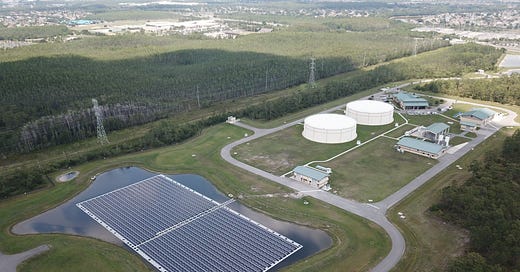Originally published on bluedotliving.com
You can’t quite call Floating Solar new, it’s been around a few years, but it’s still certainly an emerging technology in the United States. Florida, with its abundant sunshine, is at the technology’s epicenter. Enough time has elapsed to deem the technology a success.
Floating solar panels are called “floating photovoltaics”, and are similar to regular solar except differences in the racking systems and anchoring in the water. They are made from HDPE plastics that are more durable and resistant to corrosion.
D3Energy of Miami has installed all of the floating solar systems in Florida, and many of those around the country. According to Stetson Tchividjian, D3 Business Development Director, “Florida is the perfect center.”
Florida projects include the Orlando International Airport, which installed solar panels on a lake on the property, and Miami International Airport. The Orlando project was a joint partnership between the airport and Orlando Utility Commission. It is working so well that in addition to powering the airport, there is enough energy left over to feed back into the grid and power a small number of local residences.
Right now floating solar provides about 5% of the solar in the USA. Tchividjian estimates that figure could double in the near future. He says Southeast Asia countries are currently the biggest users of the technology. Industry sources expect the technology to triple worldwide in the next two years.
The big advantage of floating solar is it doesn’t require scarce and pricey real estate. “Land is at a high premium and costly,” Tchividjian says, “and roof tops sometimes are not enough space. Saving land is more and more of the conversation.”
That is what led Manheim Auto Auctions in Central Florida to floating solar. The giant car lot is filled with cars that take up all the land, and the rooftops won’t provide enough electricity. The solution was a floating solar array on a large drainage pond on the property. Tchividjian refers to it as “the perfect test case.” Manheim now has installations at two locations in the Orlando area.
The Central Florida Expressway Authority makes use of floating solar to power their traffic message signs. The arrays are anchored in retention ponds along the highway. In cases of power outages due to storms, the signs keep working to keep drivers informed of traffic conditions.
Floating solar can generate more efficient energy than traditional solar because the water helps cool the solar panels, boosting their performance. Some floating solar systems are equipped with tracking devices to follow the sun, increasing their efficiency.
In addition to renewable solar power there is an added benefit. The floating solar arrays shade the water in lakes and ponds, and consequently there is less algae. Algae is a chronic pollutant problem in lakes and ponds in Florida, leading to toxic water and fish kills.
As far as energy generation Tchividjian says the efficiency of floating units is in line with ground and roof top installations. Most Florida installations are in the 1 megawatt category, some a little larger or smaller.
The units are anchored to the bottom of the lakes, with enough slack to allow for the natural rise and fall of water levels during periods of droughts and heavy rains.
Other partners in floating solar in Florida include Duke Energy and Florida Power and Light.
When D3 first started with floating solar, Tchividjian says “people thought we were really crazy.” Now the company has installations not only in Florida but Texas, North Carolina, Delaware and Ohio. The U.S. military has installed floating solar at Fort Liberty, North Carolina, formerly Fort Bragg. The company even has a project in New Zealand. “We and the technology are rapidly growing,” Tchividjian concludes.




